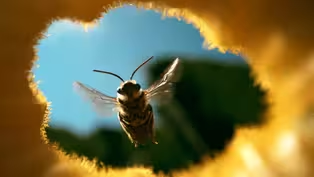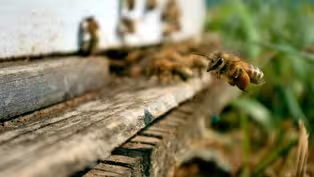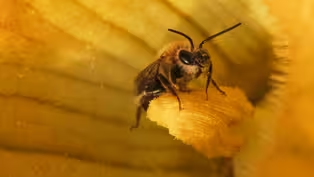
Rusty-Patched Rescue: Saving America's Wild Bees
Clip: Season 2 Episode 4 | 4m 11sVideo has Closed Captions
Clay Bolt and Shane trace the decline of wild bees — and fight to bring them back.
Wild bees like the rusty-patched bumble bee are vanishing — but not without a fight. Conservation photographer Clay Bolt shares how a rare sighting sparked a nationwide effort to protect native pollinators. Shane joins Clay in Wisconsin to witness one of North America’s rarest bees and uncovers how pesticides, habitat loss, and climate change are threatening the future of wild bees.
Problems playing video? | Closed Captioning Feedback
Problems playing video? | Closed Captioning Feedback

Rusty-Patched Rescue: Saving America's Wild Bees
Clip: Season 2 Episode 4 | 4m 11sVideo has Closed Captions
Wild bees like the rusty-patched bumble bee are vanishing — but not without a fight. Conservation photographer Clay Bolt shares how a rare sighting sparked a nationwide effort to protect native pollinators. Shane joins Clay in Wisconsin to witness one of North America’s rarest bees and uncovers how pesticides, habitat loss, and climate change are threatening the future of wild bees.
Problems playing video? | Closed Captioning Feedback
How to Watch Human Footprint
Human Footprint is available to stream on pbs.org and the free PBS App, available on iPhone, Apple TV, Android TV, Android smartphones, Amazon Fire TV, Amazon Fire Tablet, Roku, Samsung Smart TV, and Vizio.
Buy Now

Surprising Moments from Human Footprint
Do you think you know what it means to be human? In Human Footprint, Biologist Shane Campbell-Staton asks us all to think again. As he discovers, the story of our impact on the world around us is more complicated — and much more surprising — than you might realize.Providing Support for PBS.org
Learn Moreabout PBS online sponsorship(soft whooshing) (Clay) I had this epiphany that I can make the lives of millions of organisms better.
-Mm.
-And that’s not nothing, you know, that counts for something, and that gives me a lot of hope.
(Shane) Clay Bolt is manager of pollinator conservation for the World Wildlife Fund.
But his first love is documenting the lives of insects with his camera.
-(hip-hop music) -(camera shutter clicking) ♪ He started focusing on bees in 2012, when a lot of folks were sounding the alarm about honey bee populations.
-(insects chirring) -(birds chirping) (Clay) I set up my camera and imagined myself photographing honey bees for the rest of the day.
But instead, what I photographed were these two small, beautifully colored sweat bees.
Each one was smaller than a grain of rice.
And my mind was blown.
(mellow music) (Shane) Clay fell in love with native bees... (bees buzzing) ...especially bumble bees.
♪ One species captured his imagination: the rusty-patched bumble bee, a species that used to be common across the Eastern U.S. (Clay) So, one of the sort of alarming things that happened starting in the mid-’90s is that the rusty-patched disappeared from 90% of its habitat.
To the point where now if you find a rusty-patch, in a lot of its range it’s like a celebrity sighting, but this was once an incredibly common bee.
(somber music) (Shane) His quest drew him here to Madison, Wisconsin, where he saw his first rusty-patched in 2014, just a few feet from where we’re standing right now.
-(bees buzzing) -(gasps) (Clay) It’s a rusty-patched bumble bee!
-Oh!
-So, this is awesome.
This is a really rare bee.
(Shane) So, how can you tell that it’s rusty-patched?
(Clay) Well, it has this-- you can kind of see this rusty band underneath the abdomen there.
But yeah, this is one of the rarest bumble bees -in North America.
-Wow.
(Clay) It’s really special to see-- see this here.
(soft music) (Shane) It did feel...special.
♪ (bee buzzing) ♪ I could be projecting, but it seemed like even the other bees could tell this one was something a little different.
(wings flapping) -(bee buzzing) -(whooshing) After seeing his first rusty-patched in 2014, Clay put his passion to work.
(bright music) (Clay) I worked with friends to create a documentary.
(camera shutter clicking) I photographed the bee, I started writing articles, and that ultimately led, at least in part, to the bee being listed on the Endangered Species Act.
(wings flapping) (Shane) In 2017, the rusty-patched became the first North American bee species to receive federal protection.
But there are 48 other bumble bee species in the U.S., and more than a quarter of those are in serious trouble.
(Clay) Yeah, so, there’s really three main things that are primarily impacting bumble bees.
Habitat loss, pesticides, and climate change is a big factor, actually.
(whooshing) (Shane) It’s not just bumble bees.
Researchers estimate that over half of North America’s 4,000 bee species are in decline, and almost a quarter are threatened with extinction.
Some of the steepest population declines began in the 1990s.
(Clay) And this coincides with the release of a class of systemic pesticides called neonicotinoids, or neonics for short.
(mysterious music) (Shane) Neonics are insecticides that attack insects’ nervous systems.
And today, they’re just about everywhere.
♪ (Clay) Nearly 100% of field corn that’s produced in the United States has neonic-treated seeds.
Soy, wheat, and a single neonic-coated seed has enough active ingredients to kill 80,000 bees.
-Wow.
-So, no wonder we’re having these problems with our pollinators.
♪
Video has Closed Captions
Preview: S2 Ep4 | 30s | Shane investigates the future of bees, from honey bees to wild native species, in a changing world. (30s)
The Pollination Economy: Inside America's Bee Crisis
Video has Closed Captions
Clip: S2 Ep4 | 12m 42s | Shane meets the beekeepers and scientists racing to save America's pollination workforce. (12m 42s)
The Secret Life of Squash Bees
Video has Closed Captions
Clip: S2 Ep4 | 9m 58s | Margarita Lopez-Uribe reveals how squash bees evolved to thrive on our modern farms. (9m 58s)
Providing Support for PBS.org
Learn Moreabout PBS online sponsorship
- Science and Nature

Explore scientific discoveries on television's most acclaimed science documentary series.

- Science and Nature

Capturing the splendor of the natural world, from the African plains to the Antarctic ice.












Support for PBS provided by:


